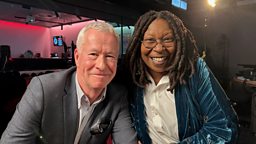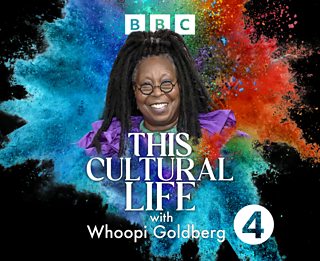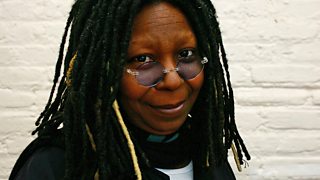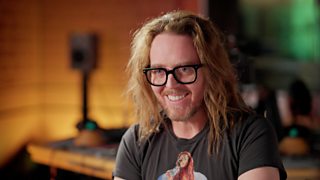Whoopi Goldberg: Nine things we learned from her This Cultural Life interview
Whoopi Goldberg is one of America’s most successful screen and stage stars. She’s one of the rare performers who can claim to be an EGOT, winning an Emmy, a Grammy, an Oscar and a Tony. Whether in films like Ghost, The Color Purple and Sister Act, or as a host of the TV show The View, she has worked consistently for 40 years.
On This Cultural Life, she tells John Wilson about her unusual education, performing for Steven Spielberg and why she regrets nothing. Here are nine things we learned.

1. She always knew she’d be an actress
Goldberg grew up in New York City, raised by her mother, Emma, a teacher. She had no obvious path into acting yet knew from the age of three that she’d act. “It was just part of me,” she says. “I suspect that’s why I didn’t even question it… I never thought I was going to be a famous movie person, but I always knew I was going to be a character actor.” She credits her mother for never discouraging her unlikely ambition. “She was just odd enough to recognise the oddity in her child,” she says. Her mother sent her to try acting at Hudson Guild, a community organisation where children could go and learn about pretty much anything, from boxing to art to pottery. “My mother never said, ‘What are you talking about?’ [when I told her I wanted to act]. She always said, ‘If you want to do that you have to learn how to do it’.”

2. She didn’t finish high school
“I was not a great pupil,” says Goldberg. “I am dyslexic, but didn’t know it at the time. At the time, they just thought I was being lazy.” Goldberg left school before graduating and made her own education. “I couldn’t take high school,” she says. “I couldn’t do it. It was really hard. And my mother said, ‘Listen, you cannot run the streets… Together we will find the places you can go – to the museums, to a lecture.” So Goldberg would go and find her own ways to learn. Her mother’s only rule was “when I come in from work and I say to you, ‘What did you learn today? Where did your mind go?’ you have to tell me.”
3. Mike Nichols changed her life
It was through her unorthodox education that Goldberg discovered theatre, watching free community productions of Shakespeare. Eventually, as a young adult, she staged her own one-woman show in a small venue, which got attention after a rave review in The New York Times. One night she was visited by Mike Nichols, the Oscar-winning director of The Graduate. “He said, ‘Would you ever want to do the show for Broadway?’ I thought he was kidding,” she says. Nichols wasn’t kidding and produced a hit Broadway transfer. He became a huge help in Goldberg’s career. “It’s hard to find people who have your best interests at heart,” she says. She credits Nichols’s visit as a pivotal moment. “There are a million zillion talented people on our planet. He could have had a headache rather than coming to see my show. What would have happened then, if he hadn’t come? Would this have still happened?”
4. She fought to be in The Color Purple
Goldberg’s big film break was 1985’s The Color Purple, directed by Steven Spielberg. It was only Goldberg’s second movie role and saw her play a woman, Celie, who suffers horrible abuse throughout her life but finds a sense of self-worth. Goldberg was campaigning to be a part of the film before it was even announced. “I wrote a letter to Alice Walker [the author of The Color Purple],” she says. “I thought the book was magnificent and I said, ‘If they ever make a movie I would like to play dirt on the floor’.” Unbeknownst to Goldberg, Walker had seen Goldberg’s show, was impressed, and sent that letter to Spielberg. “She wrote back to me saying, ‘You know, they may be making a movie. I’ll keep you posted’.”
I thought the book was magnificent and I said, ‘If they ever make a movie I would like to play dirt on the floor’.Whoopi Goldberg on The Color Purple
5. She impressed Steven Spielberg with an ET parody
As part of the audition process for The Color Purple, Spielberg wanted to see Goldberg’s show, but he couldn’t make it to New York. So he had Goldberg come perform it for him in Hollywood. “My agent said, ‘Now look, just do your show. Don’t do anything extra’.” The show went well and the audience demanded more. “I’m like, ‘OK, I have one more thing, but they told me not to do it…” The one more thing, which she did, was ‘Blee-T’, a parody of Spielberg’s ET, in which ET lands in a deprived Black neighbourhood. “He can’t phone home because none of the phones are working… They dress him like a tiny pimp… He has a gun. When his people come to get him, he doesn’t recognise them, because he’s assimilated, and he mows them down… So I say at the be-all and end-all of this, ‘Don’t make people assimilate. Let them share their experience with you’.” Spielberg loved it. “He said, ‘I’d never thought of it that way: assimilation. Someone coming from somewhere else and having to fit in.’ He said, ‘It’s one of the best things I think I’ve ever heard having to do with ET’.”
6. She doesn’t regret any of her work
Goldberg’s work has sometimes been controversial. Her one-woman show was a series of monologues about people from many different walks of life, including a drug addict and a teenager who’s just catastrophically self-administered an abortion. She discusses one monologue about a quadriplegic woman “who has disabilities that don’t allow her always to think of herself as being a hot young woman.” Wilson asks if she’d write and play the same thing today, taking on the role of someone quadriplegic. “Yeah, because you tell me what’s wrong with that.” She says she regrets none of her work. “The things I’ve done, there’s always been a reason. There was a reason I wanted to show that just because someone looks physically different doesn’t mean they’re not entitled to the same loves, the same heartbreak, the same everything as the rest of us.”

7. She was once the highest paid woman in Hollywood
Goldberg has had a hugely successful film career, getting an Oscar nomination for The Color Purple and winning one for Ghost (she has also hosted the Oscars four times). She was once the best paid female star in the world. “For about 10-minutes, I was the highest paid woman in Hollywood,” she says. That was for the sequel to Sister Act. For the first film she was paid $7 million and for the sequel she was paid $12 million.
You have to have a certain ability to work with groups of people. This is why I’m not married... I do well on my own.Whoopi Goldberg on not wanting to direct
8. She’s been trying to make her passion project for 18 years
Goldberg appears on This Cultural Life to promote her latest film, Till, about the brutal 1955 murder of 14-year-old Emmett Till and his mother Mamie’s quest for justice. Goldberg, also a producer, plays Till’s grandmother. “We’ve been trying to do it for 18 years,” she says. “It’s taken forever but I suspect now it’s happening at the right time.” She calls it a film about systemic racism but also a film about how any group can be attacked. “If you’re a gay woman, they’re talking about you. If you’re a woman who doesn’t want to wear the hijab, they’re talking about you… Take away the ‘race’ and keep the ‘-ism’ and it’s a movie for you… The only way to get it to stop happening is to show people what was and make sure it doesn’t continue.”
9. She wants to make a horror movie
When asked what keeps driving her on in her career, Goldberg says, “I get bored easily.” She says she still has ambitions but has no interest in directing: “You have to have a certain ability to work with groups of people. This is why I’m not married. I don’t do well as a pair. I do well on my own.” What she really wants to make is a horror movie. “I love horror. No-one will let me [be in one]! I keep saying to people, ‘Who better than me?!’”
More from ���˿��� Radio 4
-
![]()
Desert Island Discs: Steven Spielberg
The director is cast away to the desert island by Lauren Laverne.
-
![]()
Desert Island Discs: Whoopi Goldberg
Kirsty Young invites Whoopi Goldberg to choose eight records.
-
![]()
This Cultural Life: Tim Minchin
Comedian, actor and composer Tim Minchin reveals his creative influences.
-
![]()
This Cultural Life: Florence Pugh
Actor Florence Pugh talks to John Wilson about her career and formative influences.





